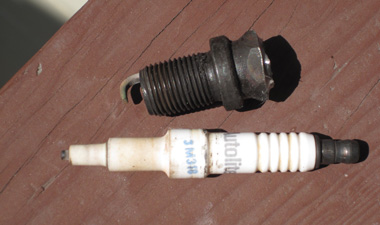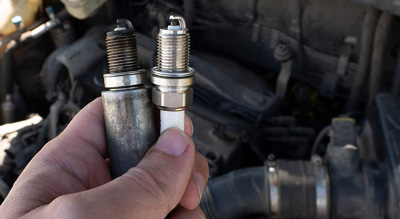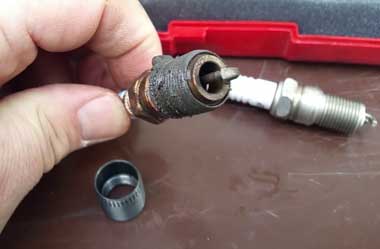White Ash on Spark Plug -[FIX Signs of Trouble + Causes]
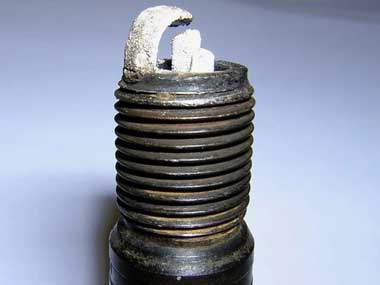
White ash is a by-product of the combustion process, and it can accumulate on spark plugs over time. When the ash collects on the electrodes, it can block the spark that ignites the fuel mixture in the engine.
This can cause your car to struggle to start in cold weather, and it can also cause other problems down the line. If you notice white ash on spark plug, it’s important to take steps to clean them off and ensure that your car will start in cold weather.
If you’re noticing a decrease in performance or smoke coming from your car, it’s time to check your spark plugs. If you’re having trouble starting your car in the winter, there’s a good chance that your spark plugs are coated in white ash.
White ash on a spark plug can indicate a problem with the plug and, if left untreated, can lead to a fire in the engine.
White Deposits on Spark Plug-What Does It Mean
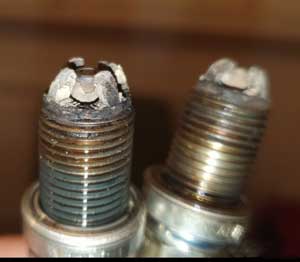
A few different things can cause deposits to build upon your spark plugs, and the most common ones are overheating and misfiring.
When these issues occur, the heat generated by the engine causes the deposited materials to expand and shatter the electrodes within the plug.
This can lead to a variety of engine problems, including decreased efficiency and possible fires.
In order to prevent these issues from happening, it’s important to keep an eye on your engine’s temperature and make sure that it’s operating at its optimal levels.
If you notice any deposits or other signs of trouble, don’t hesitate to contact a mechanic for help.
Check out What Causes Black Carbon on Spark Plugs.
What Causes Ash Deposits on Spark Plugs
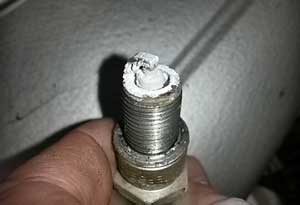
There are a number of possible causes of ash deposits on spark plugs, and most of them can be attributed to an issue with the engine or combustion chamber.
Overheating spark plugs can cause metal deposits to form on the electrodes, and this can lead to interference and reduced performance.
Sharp edges on components inside the combustion chamber can also cause metal filings to accumulate, and this can lead to spark plug failure.
Low levels of coolant, oil, or both can also cause the metal to condense and form deposits on the electrodes.
An imbalanced fuel mixture can also cause the metal to form on the electrodes, and this can lead to spark plug failure. Excessive oil can also cause the metal to condense and form deposits on the electrodes.
Why do spark plugs burn white?
There are several potential reasons why a spark plug might burn white. One of the most common is a misfire in the combustion process caused by an engine that isn’t properly tuned.
Another potential cause is an issue with the spark plug, such as a broken insulator or electrode. This will again cause the spark plug to overheat, making the porcelain turn white.
Another possible explanation is if the spark plug’s heat range is too high for the engine. This means the spark plug gets too hot, making the porcelain burn white.
What is the white ceramic on the spark plugs?
The white ceramic component is the inner portion of the spark plug. This component is usually composed of a substance called a conductive ceramic, a type of insulation material.
This insulation material helps to protect the spark plug from heat, vibration, and impact while maintaining a good electrical connection between the spark plug and the spark plug cables.
What is ash fouling?
Ash fouling is the accumulation of dust, slag, and other materials inside a boiler or furnace, reducing efficiency and eventually leading to operational issues. The burning of fuels, such as coal, oil, or wood, mainly causes it.
The fouling occurs when the soot, ash, and deposits clog the air intakes and outlet passages, trapping unburned carbon particles, ash, and other materials inside the boiler.
Can faulty spark plugs cause white smoke?
No, faulty spark plugs will not cause white smoke. White smoke is usually a sign of a more complex engine problem, such as a cracked exhaust manifold, a leak in the head gasket, or a blockage in the fuel line. While faulty spark plugs may be the source of other engine issues, they do not emit white smoke.
What does corrosion on a spark plug mean?
Corrosion on a spark plug results from a chemical reaction between the spark plug material and the environment. Corrosion can occur when certain environmental elements react with the spark plug’s metal, causing it to break down or “puncture.” This is a process called oxidant.
How to Get Rid Off White Ash On Spark Plug
Here’s how to get rid of the white ash on your spark plug:
1. The first step is to make sure the air-fuel ratio of your engine is adjusted properly. The ratio should be 14 parts air to one part fuel. This is the most common setting for engines and should be the setting used for general operating.
2. Once the air-fuel ratio has been adjusted properly, the next step is to replace the spark plug. This is done to ensure that any remaining ash has been removed from the spark plug.
3. If the ash on your spark plug isn’t coming off with a normal cleaning, then you can try using a chemical spark plug cleaner. This will help to loosen the ash and make it easier to remove.
4. If the spark plug still doesn’t look clean after the cleaning, then you should replace it with a new one. Replacement spark plugs are relatively cheap and should last for a long time.
5. Once the new spark plug has been installed, you should make sure to readjust the air-fuel ratio to the correct setting. This should keep the engine running at peak efficiency and should reduce the presence of white ash on the spark plug.
White Ash Deposits on Spark Plug
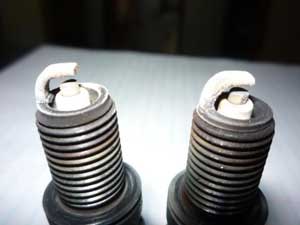
There are a few potential causes for white ash deposits on spark plugs, and low coolant or oil level is likely not one of them.
When spark plugs are fouled with white ash, the heat generated by the plug can cause the ash to form.
A low coolant or oil level would not be a sufficient enough temperature to cause this type of deposit.
It is possible that incorrectly tightened plugs could be the cause, but this is much less likely. Spark plugs should be tightened to a torque of 10 in-lbs (14 Nm), and if they are not, they should be replaced.
White Spots on Spark Plug
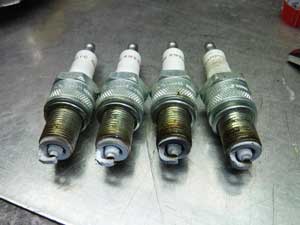
There are many reasons why white ash deposits may form on spark plugs, and the most common is when the plug becomes fouled with carbon.
This can be caused by a variety of factors, including improper engine maintenance, contamination from the air, or faulty combustion.
First, try to determine which component is causing the problem to fix the issue. This can be done by checking the piston (if the engine is diesel), the valves (if the engine is petrol), or the spark plug. If the problem is with the spark plug, the best course of action is to replace it.
What Causes White Deposits on Spark Plugs
There are many reasons why white ash deposits may appear on spark plugs. The most common reasons are low-quality fuel, worn spark plugs, and an unstable air-fuel mixture.
If the car is using low-quality fuel, it will tend to produce more heat and thus lead to a higher probability of white ash deposits appearing on spark plugs.
Spark plugs will wear as a result of this unstable air-fuel mixture, and over time this can lead to a loss of performance and possible engine damage. It may also be necessary to replace the entire spark plug array in some cases.
What Does It Mean When Your Spark Plug Is White
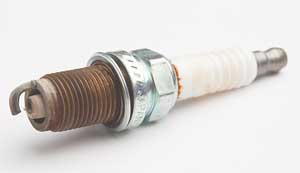
If your spark plug is white and the engine is overheating, the most likely cause is a burned spark. A spark plug is an electrical device that creates a spark when it’s activated, and this spark ignites the air/fuel mixture in the engine.
If the plug is burned, it will no longer create a spark – which means the engine will overheat and may even catch on fire.
To prevent this from happening, always inspect your plugs and replace them if they are burned or fouled.
Additionally, make sure that the air/fuel mixture in your engine is at the correct temperature by checking your coolant level and fuel injector settings.
What Color Should Spark Be on Spark Plug
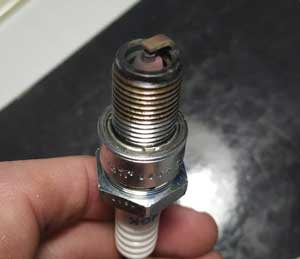
Spark plugs are one of the most important components of your car, and it is important to keep them in good condition. One way to do this is to check the color of the spark plug every time you change the oil.
The recommended spark plug color for your car is light tan or gray. This color will help to prevent misfires, and it will also make it easier to see the plug when you are working on your car.
Do Spark Plugs Need To Be Torqued?
White On Tip of Spark Plug
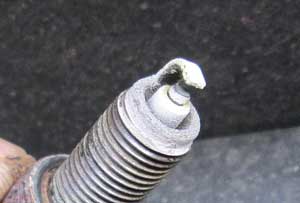
If you are seeing white on the tip of your spark plug, then it is time to replace its spark plug. This happens when the air/fuel mixture in the engine is not burning properly, and the spark plug becomes coated with white heat. This can cause misfires, loss of power, and even engine damage.
Signs that your spark plug is running too hot include:
– inability to start the engine
– misfires
– poor performance in cold weather
– black smoke coming from the tailpipe
– a “pinging” noise when you apply the brakes
– difficulty accelerating
If you notice any of these symptoms, it is time to replace your spark plug. You can do this yourself, but it is recommended that you take your car to a mechanic for a professional installation.
Should You use Spark Plug Anti Seize Lubricants to Peak Torque Rpm?
Frequently Asked Questions
1. What causes a spark plug to overheat?
A spark plug overheats when the air/fuel mixture detonates prematurely in the engine, causing an explosion and heat.
This can often occur due to the ignition timing being over-advanced, which allows the air/fuel mixture to detonate too soon.
This can be caused by worn or corroded spark plugs, dirty air filters, or a misfiring engine. In order to prevent a spark or plug from overheating, it is important to have it replaced when it starts misfiring or shows signs of corrosion.
2. What does glazing of the spark plug look like?
If you are seeing a yellow or varnish-like color on your spark plug, it is likely that the glazing is not sealing properly and is allowing air to enter the engine.
This can cause the engine to overheat and may even result in a fire. If you notice this happening, you should take your car to a mechanic as soon as possible to have the spark plug replaced.
Conclusion
If you’re like most drivers, your car’s engine is one of the most important components in its performance.
But just like any other piece of equipment, your engine needs regular maintenance to keep it running smoothly.
In this article, we have shown you how to take care of your white ash spark plugs, one of the most important parts of your engine.
By following our tips, you’ll keep your car running like new and avoid costly repairs down the road and how to fix white ash on spark plug.


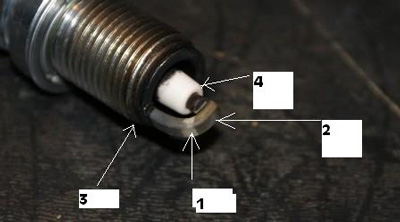
![How To Tell If a Spark Plug Hole Is Stripped [With Steps]](https://torqueadvisor.com/wp-content/uploads/2022/04/How-To-Tell-If-a-Spark-Plug-Hole-Is-Stripped-1.jpg)
